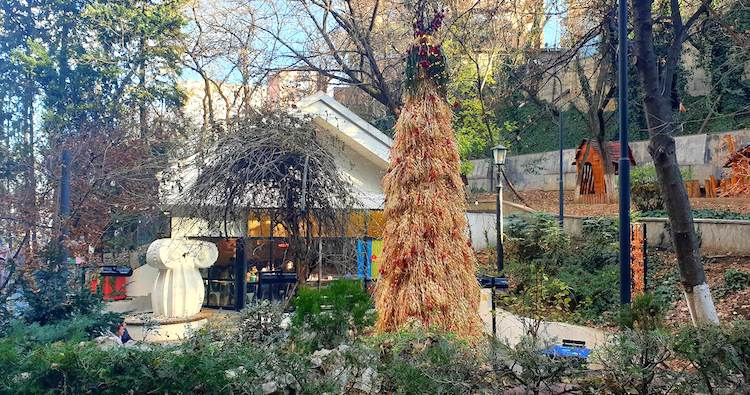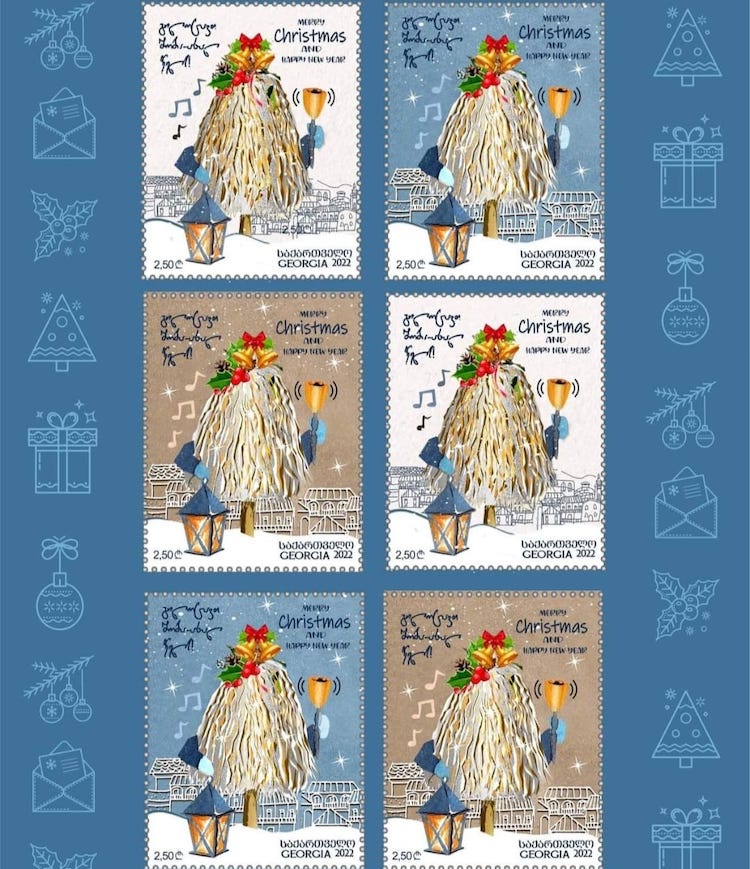Chichilaki: reflecting on long tradition of Georgian Christmas tree

Chichilaki trees vary in length between 20cm to a few metres, and are recognised for their environmentally friendly production, as they are made from pruned branches - in contrast with the logging of spruce trees for making the widely used Christmas trees. Photo: Nino Alavidze/Agenda.ge

In Georgia, just like the parts of the world where Christmas is marked, Christmas trees are adorned and lit, with presents hidden under their lower branches. But the country also has a special Christmas tree - the chichilaki - which symbolises the sun and the tree of life, and is believed to bring bountiful harvest across the country and a hope for a better future.
The main attributes of the original chichilaki were two bow-shaped elements, called kalpi and bokeri, the former made from ivy leaves and the latter being a bread baked with eggs, flour and cheese, as a symbol of life and fertility. Symbols associated with chichilaki have led to the trees being decorated with little red berries and dried fruits.
 Photo: Nino Alavidze/Agenda.ge
Photo: Nino Alavidze/Agenda.ge
The custom of Christmas pine tree decorations in Georgia dates back to the 18th century. Further back in history, New Year’s Eve was celebrated at different periods of the year - some in August and the first month of the spring - but since the 14th century, the country has celebrated the date at midnight on December 31.
The history of chichilaki
Chichilaki originated in the western Georgian provinces of Guria and Samegrelo, while its matching Khoncha - a decorated board tray with bread, sweets, pomegranate, nuts and wine - originated in eastern parts of the country.
 Photo: Nino Alavidze/Agenda.ge
Photo: Nino Alavidze/Agenda.ge
The making of the tree starts with the cutting of hazelnut tree branches, which are then put in water before the New Year’s Eve, and later dried in front of stoves.
The branches are repeatedly shaved from below with a special knife, with the resulting curly fronds kept attached at the top and representing “rays” to symbolise the allegory of the sun.
There is also another legend that says the fronds’ association is with the beard of Saint Basil the Great, who is said to visit people during Christmas much like Santa Claus.
 Photo: Nino Alavidze/Agenda.ge
Photo: Nino Alavidze/Agenda.ge
In early eras, a ring of reeds was attached to the top of chichilaki. It was later replaced with a cross, marking a joining of pagan traditions with Christianity.
Chichilaki trees vary in length between 20cm to a few metres, and are recognised for their environmentally friendly production, as they are made from pruned branches - in contrast with the logging of spruce trees for making the widely used Christmas trees.
Chichilaki is the sun, and the sun is fire - chichilaki trees are ceremoniously burned on the day before the Georgian Orthodox Epiphany on January 19, to symbolise the end of the previous year's troubles.
Tbilisi Zoo invites city residents to donate chichilakis
Have you ever seen bears play with chichilaki trees? If you visit Tbilisi Zoo after the New Year’s Eve celebrations, you will have a chance of witnessing the scene, stemming from the tradition of residents of the city to bring their used chichilakis to the Zoo instead of burning them.
 Photo: Tbilisi Zoo
Photo: Tbilisi Zoo
The Zoo has been asking people to donate their old chichilaki and Christmas trees since 2015, saying they can be used to “improve surroundings for our animals”. Chichilakis are used to entertain them, with bears, rhinos, macaques and others seen playing with the trees.
The Zoo has said adding amusement elements and puzzles to their environment serves to enrich the surroundings for its residents, with Director Zurab Gurielidze noting the deer prefer Christmas trees because they can rub their antlers against them. “Christmas trees help us create a natural environment for them”, he pointed out.
 Photo: Tbilisi Zoo
Photo: Tbilisi Zoo
Chichilaki marks launch of charity campaign for children in Guria
In this year’s holiday season, charity platform charte.ge and the inclusive Cafe Mziuri in Tbilisi’s Mziuri Park teamed up to provide internet access to six school graduates in the country’s western Guria.
The youngsters were also provided with mentorship, guidebooks, training in media literacy, financial literacy and online education, as well as free access to a range of educational platforms as part of the move.
 Photo: Nino Alavidze/Agenda.ge
Photo: Nino Alavidze/Agenda.ge
The campaign was launched on the backdrop of a chichilaki in the popular Cafe on December 10, with owner, photographer and activist Ana Goguadze explaining the tree’s origins in Guria had served to design the charity for young residents of the region.
"We have a tradition of lighting up the Mziuri Christmas tree with our visitors every year, and this year, for the first time, we are having a very large chichilaki”, she told Georgian media.
 Photo: Nino Alavidze/Agenda.ge
Photo: Nino Alavidze/Agenda.ge
“We wanted to also do something useful with our friends and supporters this year”, Goguadze said, explaining “we want to fund internet access for school-age children [...] because access to education is very important. Since this year we are having a chichilaki from Guria for the first time, we decided to finance internet access for six high-school students living in Guria, with the number also linked to the sixth anniversary of the Cafe”.
Chichilaki displayed outside the Orbeliani Palace of Georgian President
The yard of the Residence of the President of Georgia in Tbilisi, also known as the Orbeliani Palace, has been decorated with Christmas and New Year’s Eve decorations, with a chichilaki also on display in the central section.
 Photo: Nino Alavidze/Agenda.ge
Photo: Nino Alavidze/Agenda.ge
President Salome Zurabishvili is known for promoting the use of chichilaki both among locals and internationally, and launched an initiative on adding western Georgian traditions of New Year's Eve celebrations - including the chichilaki - to the UNESCO Intangible Cultural Heritage List.
The President often uses chichilaki as a Christmas present in her wishes for a Happy New Year.
Chichilaki post stamp promotes tourism in Guria
A new post stamp featuring an illustration of a chichilaki was released this month for promoting the Guria region as a tourist destination.
 Photo: Zurab Nasaria/Facebook
Photo: Zurab Nasaria/Facebook
Regional Governor Zurab Nasaria revealed the news on his social media profile this week, noting the stamp was the first product of a joint Georgian-Polish project on promoting the region for prospective visitors.
He said the stamp had been produced in cooperation with the Post Office of Georgia and featured a line from a work of the popular poet Ana Kalandadze referencing the tree.
Printed in France, the stamp will “play its role in attracting visitors” to Guria, the Governor told his social media followers.
 Tweet
Tweet  Share
Share